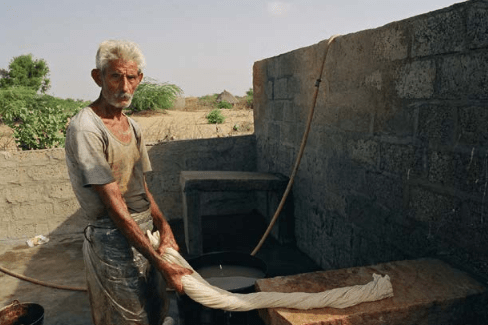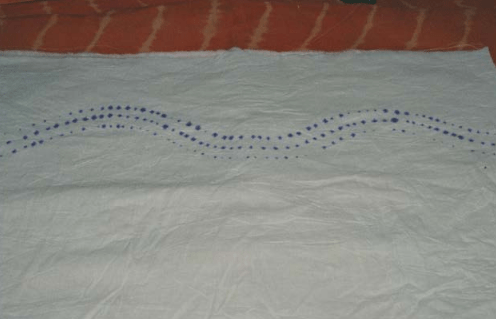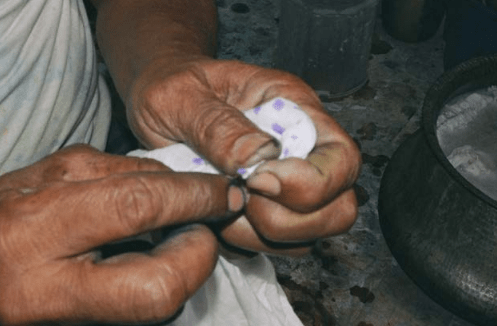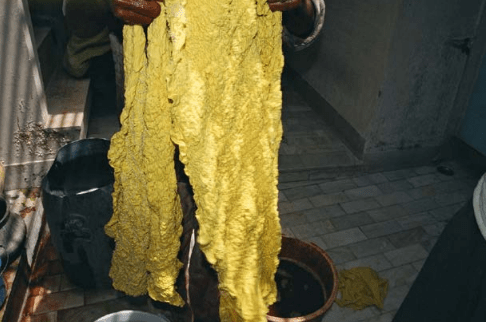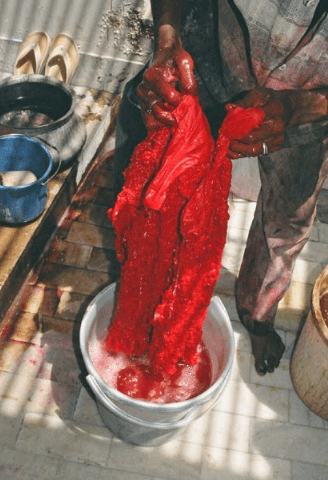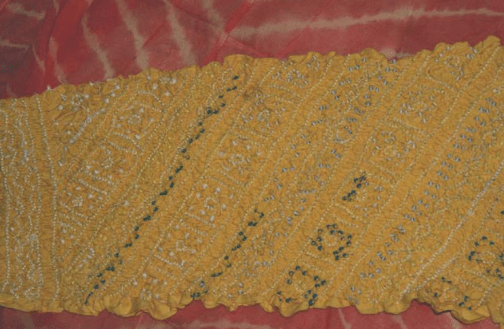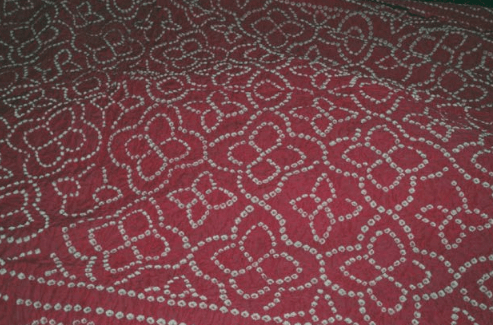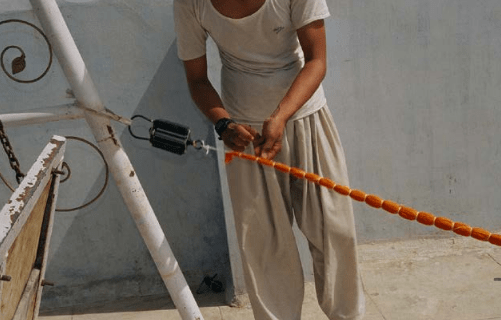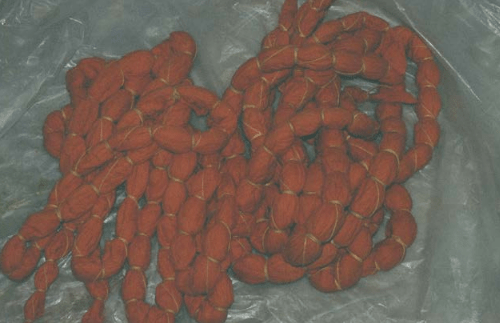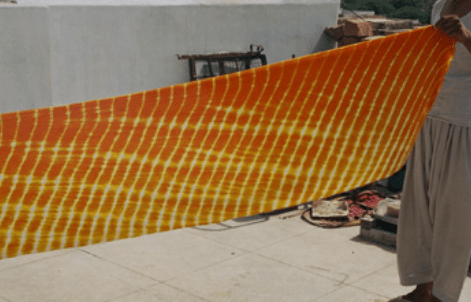Tie and dye techniques, a form of resist dyeing, is a technique of patterning fabric by tying parts of it in different ways to prevent the penetration of dyes. This craft is one of the oldest in the world for making colored designs on a fabric.
Its definite origin is unknown, but the earliest information of this craft can be achieved from books and other records of the 6thcentury AD which are to be found in the East, particularly in China, India, Japan and Indonesia.
Records also say that this craft was in existence in South America and Africa during the 5thcentury. Europe has only recently discovered the creative possibilities of tie and dye.
Tie and dye techniques
The technique involves dyeing a fabric which is tied tightly with a thread at several points in various colors, thus producing a variety of patterns like Lehriya, Mothda, Ekdali and Shikari depending on the manner in which the cloth is tied.
Tie and dye (resist-dyeing technique) is classified into three categories.
a)Either warp is tied and dyed or the weft is tied and dyed, for example, single lkat*, Mashru.
b) Tie both the warp and weft and dye, for example: Double lkat, Patola, Telia Rumal.
c) Tie the fabric and dye, for example, Bandhani*, Lehariya* and Mothra., Shibori*
Regions
Centers for Bandhani are Mandvi, Jamnagar, and Mundra in Gujarat and Jodhpur, Jaipur and Udaipur in Rajasthan. A specialty of Rajasthan is the Leheriya or Chundari where the fabric is tied to create stripes instead of the usual dots.
A specialty of Gujarat is the Gharchola sari with a very fine design of animals, birds and figures set in a square format. Madhya Pradesh has a coarser Bandhani with bigger dots and bolder and more abstract designs.
Madurai in Tamil Nadu has a type of Bandhani known as Changudi with small dots in a single color all over the fabric and a plain contrast border.
Producer communities
It is widely believed that it was brought to Kutch from Sindh by Muslim Khatris who are still the largest community involved in the craft.
Raw materials
The fabrics used for are muslin, handloom, silk or voile (80/100 or 100/120 count preferably in voile).
The dominant colors are bright like yellow, red, green, and pink. Maroon is also an all-time favorite. Traditionally vegetable dyes were used but today chemical dyes are becoming very popular. Various synthetic fabrics are also highly in demand. For tying knots mostly synthetic thread is used on the fabric.
Popular dyes used in the tie and dye processes are:
i) Vat Dyes: Vat dyes are an ancient class of dyes based on the original natural dye, indigo, which is now produced synthetically. Cotton and wool, as well as other fibers, can be dyed with vat dyes. ‘Vat dyeing’ means dyeing in a bucket or vat.
It can be done whenever a solid, even shade, i.e. the same color over the entire garment, is wanted. It can be done using almost any dye, including fiber reactive dyes, direct dyes, acid dyes, etc. The opposite of vat dyeing is direct dye application, for example, tie and dye.
ii) Direct Dyes: Also known as hot water dyes, direct dyes can be used with hot water and require no binding or exhausting agents. They are convenient but lack in color fastness and wash fastness. They are used on cotton, wool, silk and nylon.
The colors of direct dyes are duller than those provided by reactive dyes. They can be found in a powder form as well as in the form of a liquid concentrate. They do not require any form of ‘fixing’.
iii) Napthol Dyes: These are two sets of chemicals which, upon reaction, produce a third chemical, essentially colorful in nature.
The fabric is dyed with one and later printed with the other. The chemical reaction produces a third color. However, the biggest drawback of this process is that there are just a few chemicals available which produce colors upon reaction.
iv) Procion Dyes: Procion fiber reactive dyes are specially formulated for cellulose fibers like cotton, linen and rayon. They also work well on silk. They are considered ‘cold water’ dyes making them great for solar dyeing, tie and dye and batik.
As for the auxiliary chemicals, all you need is salt and soda ash. Synthrapol is optional but very helpful for rinsing out excess dye. Procion fiber reactive dyes can also be used on protein fibers but different auxiliaries are needed and the dye bath must be simmered.
Tools
Although there is no tool required for the process, in some places in Rajasthan the craftsmen wear a metal ring with a protruded point to facilitate the lifting of cloth for tying.
Process
The basic process has the following steps:
i)Preparation of materials (washing and cleaning)
ii) Printing of the motif
The fabric is folded into four or more layers before tying
iii) Tying of the motifs
iv) Dipping of the textile in the lightest color
v) Touching the textile with a light color
Light color textile
vi) Removal of the knots and then dyeing in the next darker color
vii) Renewal of the tying and dyeing with the darkest color
Tying and dyeing with dark colors
viii) Washing of the fabric
ix) Opening the knots
Opening the knots
For simple designs in Bandhani*, the artisans draw directly on the cloth. For more complicated designs, the design is first printed on to it with a washable solution of geru (red ochre color).
At some places to print the design on the cloth, a wooden block with nails is used that imprints the pattern when pressed on to the folded cloth.
After the design has been marked, the cloth is given out for tying to women and young adults in the locality and then the raised portions are tied with a thread coated with a resist paste.
The little finger of the left hand pushes up the portion to be tied and it is tied three or four times. The tying is slightly wider than the dot spot or ring in the design as the dye spreads a little.
Then the cloth is dyed, either by dipping the cloth into the dye solution or dabbing the color on to it with cloth.
The technique of dyeing Bandhani involves repeated tying and dyeing in several colors. For each color the portions to remain undyed are tied up with cloth.
One starts with the lightest color and goes on till the darkest. The dying is done with a cloth dipped in color or color brushed over the required areas. After the dyeing is over the cloth is dipped in a solution of castor oil and dried.
The traditional colors used are turmeric, indigo and alum for yellow, blue and red respectively but nowadays different type of dyes like vat, napthol, direct, and procion are used. The pattern fully emerges when the knots are untied.
The Pattern
The Leheriya technique is quite different from the Bandhani technique although this too is a tie and dye process. Here the fabric is rolled from one corner to the other diagonally and then it is tied at intervals with strings.
Mothra is an extension of Leheriya in which diagonal lines cross each other in opposite directions, at 45 degrees, giving rise to small diamond shapes.
Leheriya print after dying
Leheriya print after opening the ties
Ikat is a resist-dyeing technique wherein the resist dyeing is done prior to the weaving. The warp and weft threads are separately tie-dyed and woven. First the warp is dyed in the lightest color, after this the threads are stretched on a wooden frame and the design is drawn with a pencil.
These areas are tied with wax thread. Then the thread is dyed in the next color. This process is repeated till the darkest color has been dyed and the design is complete.
The weft threads can also be treated in the same fashion depending upon the requirement. When the two sets of threads are woven together the designs of the warp and weft merge together creating subtle and pleasing patterns.
Product and their uses
As per the designer’s imagination a complete range of products can be created using tie and dye fabrics, for example, shirts, dupattas (odhnis) and various types of garments, scarves, shawls, etc.
Motifs/designs
Various traditional motifs like flowers, trees, animals, geometric designs, etc., are used to decorate the fabric. The price of Bandhani depends on the base fabric used, the intricacy and fineness of the design and the number of colors used. A fully worked sari with figures and animal designs in small dots using five colors may take six to eight months to complete.
Changes over the years
Nowadays, these textiles are occupying a good place in the national and international markets. In the olden days the craftsmen catered to the demand of the local community so they used their imagination. Today, however, the colors and motifs used are largely dependent on market demand which is influencing the traditional techniques, colors and motifs


